Ladybug
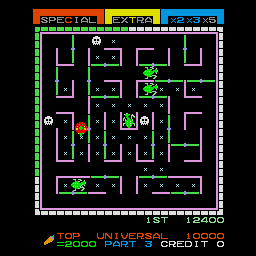 The Game: You control a nice, big, juicy ladybug waddling around a complex maze, gobbling up food and avoiding your nasty fellow insects. Doors in the maze can throw pursuers off your track momentarily – or they can trap you into an even worse situation than whatever you’re trying to escape. (Universal, 1981)
The Game: You control a nice, big, juicy ladybug waddling around a complex maze, gobbling up food and avoiding your nasty fellow insects. Doors in the maze can throw pursuers off your track momentarily – or they can trap you into an even worse situation than whatever you’re trying to escape. (Universal, 1981)
Memories: Like Lock ‘n’ Chase, Ladybug is a fine example of a game which, though clearly inspired by Pac-Man, features enough unique game play elements to make it an individual game. And it’s a rare instance of a game I have to praise for its music and sound effects – they were really rather catchy. [read more]

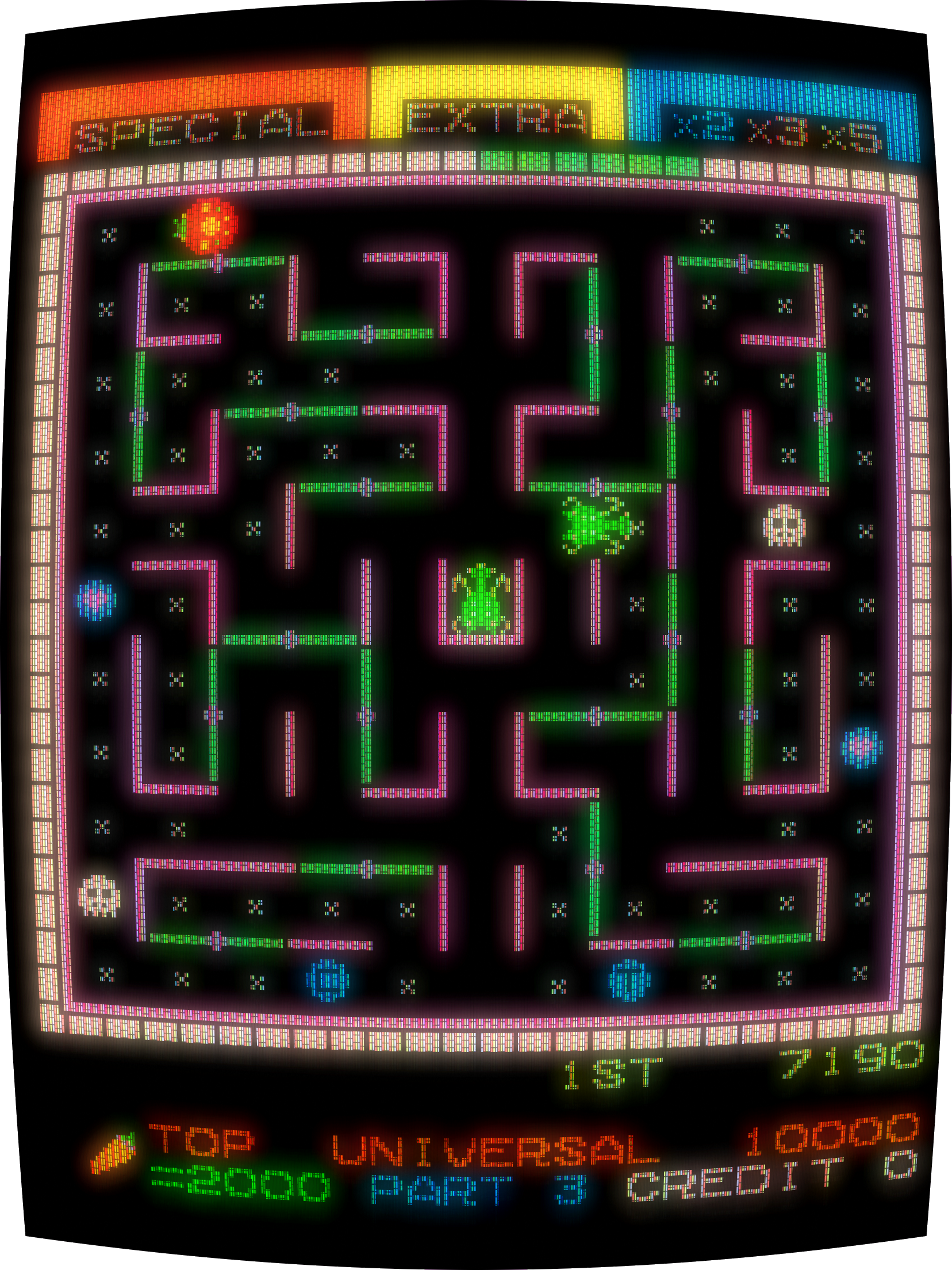
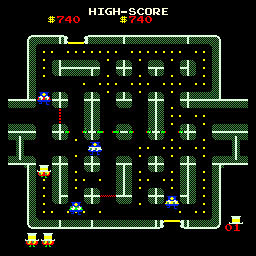 The Game: You’re in charge of a getaway car loaded with crafty criminals. Your job is to sneak around the maze, avoid four colorful cops who are hot on your trail, and grab all the dough – and, of course, to escape so you can steal again another day. But the cops can trap you with a series of doors that can prevent you from getting away… (Data East, 1981)
The Game: You’re in charge of a getaway car loaded with crafty criminals. Your job is to sneak around the maze, avoid four colorful cops who are hot on your trail, and grab all the dough – and, of course, to escape so you can steal again another day. But the cops can trap you with a series of doors that can prevent you from getting away… (Data East, 1981)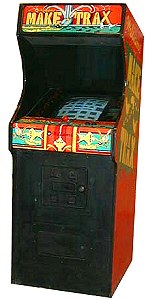 The Game: You play the part of a free-roaming paintbrush, trying to fill an entire maze with color. Unfortunately, a couple of equally free-roaming (and, apparently, amphibious) fish are out to stop you. You must avoid them at all costs. There are two rollers you can use to squish the fish, but they’re only found in two parts of the maze – and you can only roll them so far. Periodically, such things as kittens, cars, and mice will run through the maze, leaving tracks in your fresh paint which you must then cover up. You can also stop them dead in their tracks by running over them. (Don’t ask me why two fish are a threat to you when your paintbrush can ice a whole car.) Fill the maze with the pigment of your imagination, and you’re off to the next level. (Williams Electronics [licensed from Kural Electric], 1981)
The Game: You play the part of a free-roaming paintbrush, trying to fill an entire maze with color. Unfortunately, a couple of equally free-roaming (and, apparently, amphibious) fish are out to stop you. You must avoid them at all costs. There are two rollers you can use to squish the fish, but they’re only found in two parts of the maze – and you can only roll them so far. Periodically, such things as kittens, cars, and mice will run through the maze, leaving tracks in your fresh paint which you must then cover up. You can also stop them dead in their tracks by running over them. (Don’t ask me why two fish are a threat to you when your paintbrush can ice a whole car.) Fill the maze with the pigment of your imagination, and you’re off to the next level. (Williams Electronics [licensed from Kural Electric], 1981) The Game: In this munching-maze game (one of the dozens of such games which popped up in the wake of Pac-Man), you control a cartoonish mouse who scurries around a cheese-filled maze which can only be navigated by strategically opening and closing yellow, red and blue doors with their color-coded buttons. Occasionally a big chunk o’ cheese can be gobbled for extra points. Is it that easy? No. There is also a herd of hungry kitties who would love a mousy morsel. But you’re not defenseless. By eating a bone (the equivalent of Pac-Man‘s power pellets), you can transform into a dog, capable of eating the cats. But each bone’s effects only last for a little while, after which you revert to a defenseless mouse. (Exidy, 1981)
The Game: In this munching-maze game (one of the dozens of such games which popped up in the wake of Pac-Man), you control a cartoonish mouse who scurries around a cheese-filled maze which can only be navigated by strategically opening and closing yellow, red and blue doors with their color-coded buttons. Occasionally a big chunk o’ cheese can be gobbled for extra points. Is it that easy? No. There is also a herd of hungry kitties who would love a mousy morsel. But you’re not defenseless. By eating a bone (the equivalent of Pac-Man‘s power pellets), you can transform into a dog, capable of eating the cats. But each bone’s effects only last for a little while, after which you revert to a defenseless mouse. (Exidy, 1981)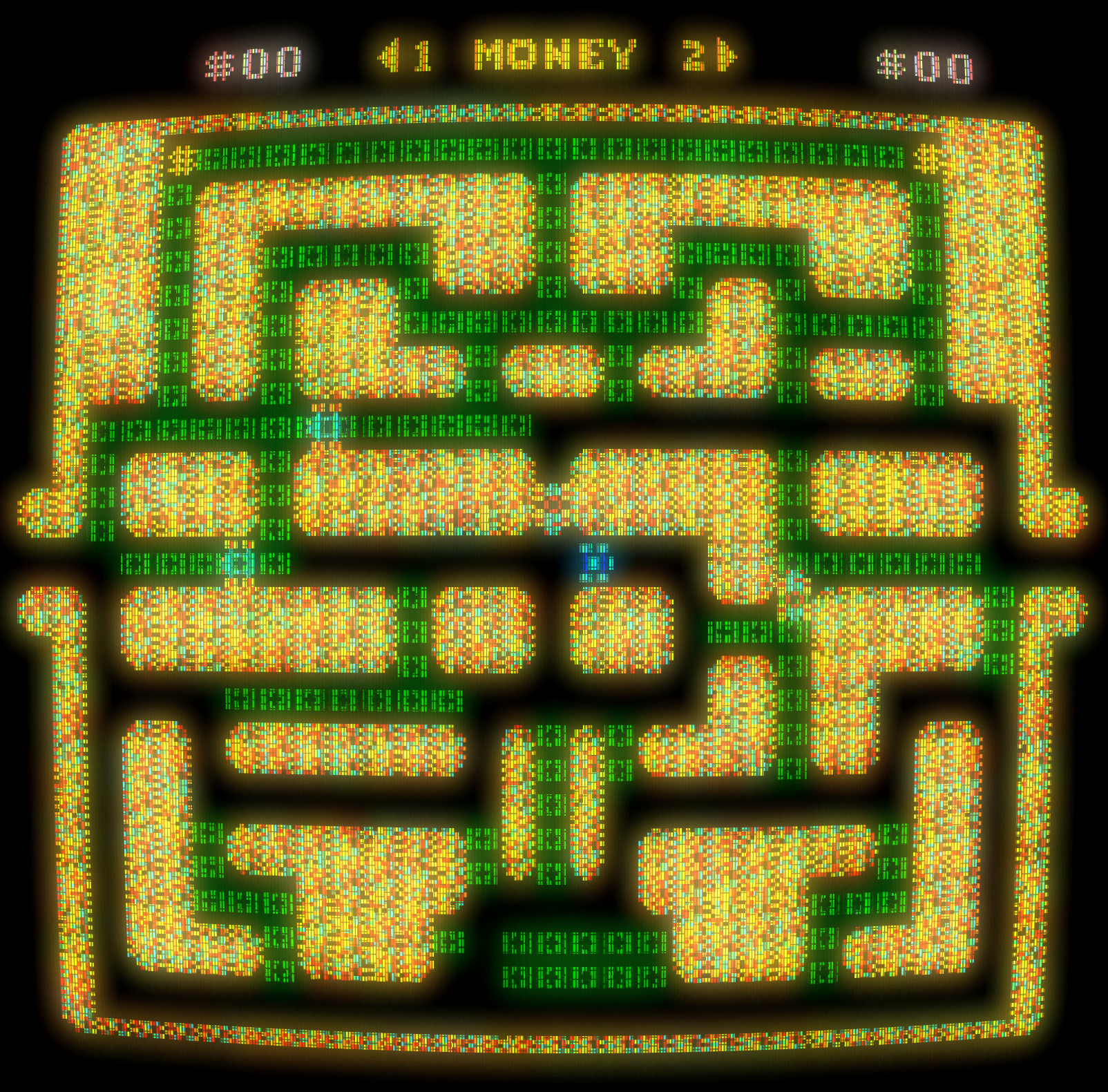
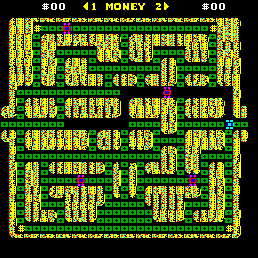 The Game: You’re on the run from the long arm of the law, and the police radio dispatchers have put an an APB out for you. Money lines the city streets, and you must evade the cop cars and stash away all the cash until the screen is cleared. Four special items in the corners of the screen enable you to turn the table on your pursuers and temporarily eliminate them from the screen – but they’ll be back. If the police cars catch you, you have the right to remain silent; if they catch your last getaway car, you have the right to see “game over” on the screen. (Pacific Novelty, 1981)
The Game: You’re on the run from the long arm of the law, and the police radio dispatchers have put an an APB out for you. Money lines the city streets, and you must evade the cop cars and stash away all the cash until the screen is cleared. Four special items in the corners of the screen enable you to turn the table on your pursuers and temporarily eliminate them from the screen – but they’ll be back. If the police cars catch you, you have the right to remain silent; if they catch your last getaway car, you have the right to see “game over” on the screen. (Pacific Novelty, 1981)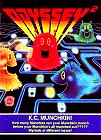 The Game: As a small blue spherical creature whose sole sensory organs consist of two eyes, two antennae and an enormous mouth, you are on a mission to eat twelve dots which are floating around a small maze. Pursuing you are three multicolored jellyfish-like horrors who will gobble you up on contact. (North American Philips, 1981)
The Game: As a small blue spherical creature whose sole sensory organs consist of two eyes, two antennae and an enormous mouth, you are on a mission to eat twelve dots which are floating around a small maze. Pursuing you are three multicolored jellyfish-like horrors who will gobble you up on contact. (North American Philips, 1981)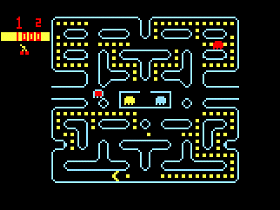 The Game: As a round yellow creature consisting of a mouth and nothing else, you maneuver around a relatively simple maze, gobbling small dots and evading four colorful monsters who can eat you on contact. In four corners of the screen, large flashing dots enable you to turn the tables and eat the monsters for a brief period. Periodically, assorted items appear near the center of the maze, and you can consume these for additional points as well. The monsters, once eaten, return to their home base in ghost form and return to chase you anew. If cleared of dots, the maze refills and the game starts again, but just a little bit faster… (Bally, 1981)
The Game: As a round yellow creature consisting of a mouth and nothing else, you maneuver around a relatively simple maze, gobbling small dots and evading four colorful monsters who can eat you on contact. In four corners of the screen, large flashing dots enable you to turn the tables and eat the monsters for a brief period. Periodically, assorted items appear near the center of the maze, and you can consume these for additional points as well. The monsters, once eaten, return to their home base in ghost form and return to chase you anew. If cleared of dots, the maze refills and the game starts again, but just a little bit faster… (Bally, 1981)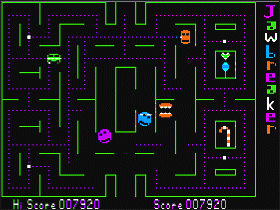 The Game: You’re a mobile set of chattering teeth, gobbling up goodies in a maze as jaw-breaking candies pursue you. If you bite down on one of these killer candies, you’ll rack up quite a dental bill (enough to lose a life). You can snag one of four snacks in the corners of the maze and suddenly the tooth-rotting treats become crunchy and vulnerable. Advance to the next level by clearing the maze of dots. (On-Line Systems, 1981)
The Game: You’re a mobile set of chattering teeth, gobbling up goodies in a maze as jaw-breaking candies pursue you. If you bite down on one of these killer candies, you’ll rack up quite a dental bill (enough to lose a life). You can snag one of four snacks in the corners of the maze and suddenly the tooth-rotting treats become crunchy and vulnerable. Advance to the next level by clearing the maze of dots. (On-Line Systems, 1981) The Game: As a round white creature consisting of a mouth and nothing else, and apparently somehow tied to the Internal Revenue Service, you maneuver around a relatively simple maze, gobbling small dots and evading four colorful monsters who can eat you on contact. In four corners of the screen, large flashing dots enable you to turn the tables and eat the monsters for a brief period for an escalating score. Periodically, assorted items appear near the center of the maze, and you can consume these for additional points as well. The monsters, once eaten, return to their home base in ghost form and, after spending some noncorporeal time floating around and contemplating taxation without representation, return to chase you anew. If cleared of dots, the maze refills and the game starts again, but just a little bit faster… (H.A.L. Labs, 1981)
The Game: As a round white creature consisting of a mouth and nothing else, and apparently somehow tied to the Internal Revenue Service, you maneuver around a relatively simple maze, gobbling small dots and evading four colorful monsters who can eat you on contact. In four corners of the screen, large flashing dots enable you to turn the tables and eat the monsters for a brief period for an escalating score. Periodically, assorted items appear near the center of the maze, and you can consume these for additional points as well. The monsters, once eaten, return to their home base in ghost form and, after spending some noncorporeal time floating around and contemplating taxation without representation, return to chase you anew. If cleared of dots, the maze refills and the game starts again, but just a little bit faster… (H.A.L. Labs, 1981)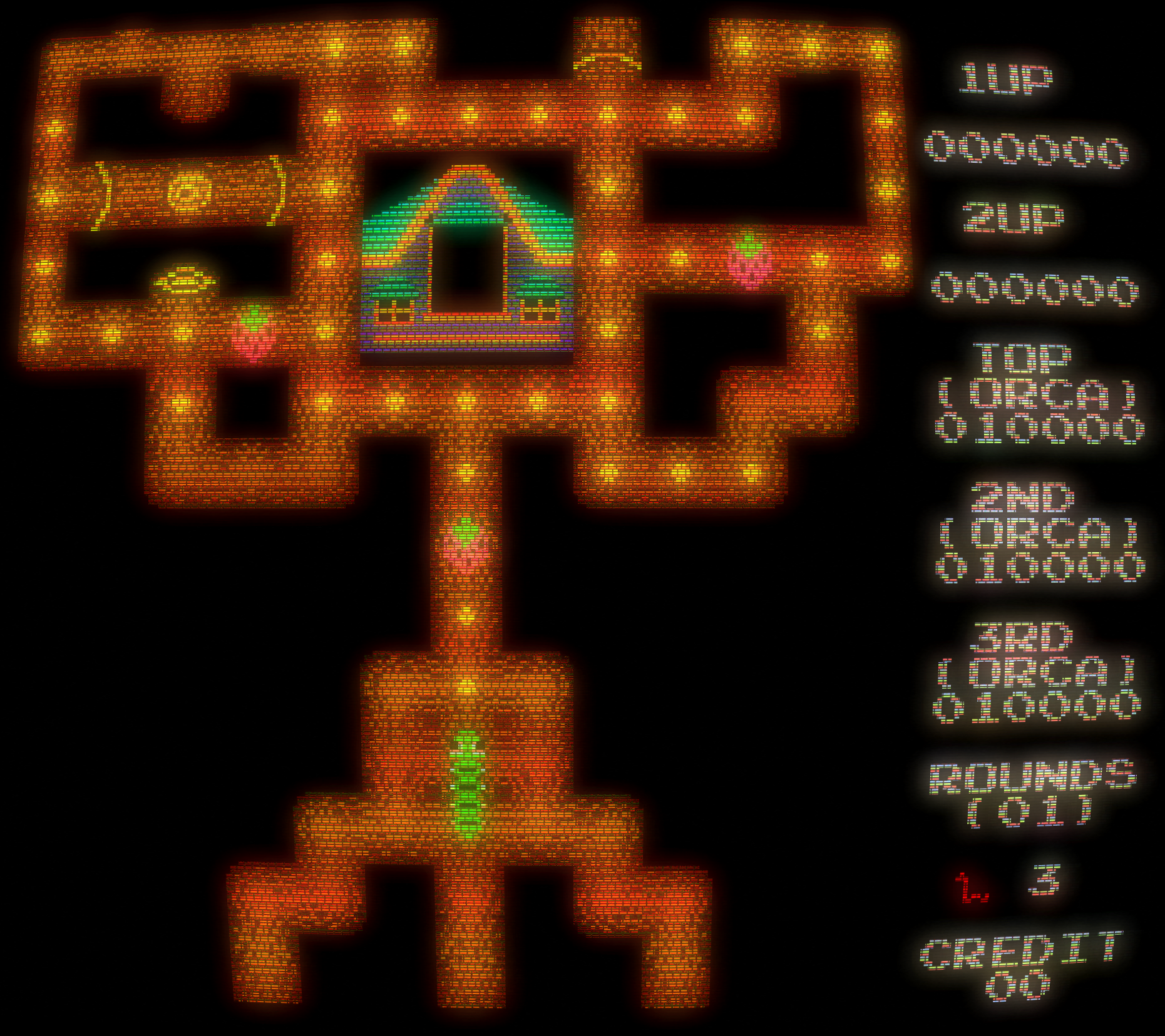
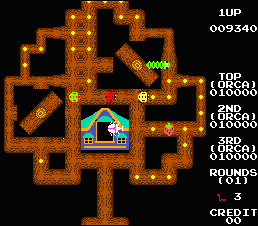 The Game: Players guide a caterpillar around a maze of twigs and branches, snatching up nourishment and the occasional treat, and avoiding other insect life; some parts of the branches can be turned. Some of the treats will allow the caterpillar to consume other insects for a brief time. Portions of the maze can be rotated, which can work against the player (cutting off the best or only escape route) or can work to the player’s advantage (effectively shutting a door in pursuers’ faces, or even smashing them if they’re in the wrong place at the right time). Clearing the maze allows the caterpillar to turn into a butterfly and escape (who needs a pupal stage anyway?); the player advances to the next level, where a new caterpillar needs help navigating a new maze. (Orca, 1982)
The Game: Players guide a caterpillar around a maze of twigs and branches, snatching up nourishment and the occasional treat, and avoiding other insect life; some parts of the branches can be turned. Some of the treats will allow the caterpillar to consume other insects for a brief time. Portions of the maze can be rotated, which can work against the player (cutting off the best or only escape route) or can work to the player’s advantage (effectively shutting a door in pursuers’ faces, or even smashing them if they’re in the wrong place at the right time). Clearing the maze allows the caterpillar to turn into a butterfly and escape (who needs a pupal stage anyway?); the player advances to the next level, where a new caterpillar needs help navigating a new maze. (Orca, 1982)